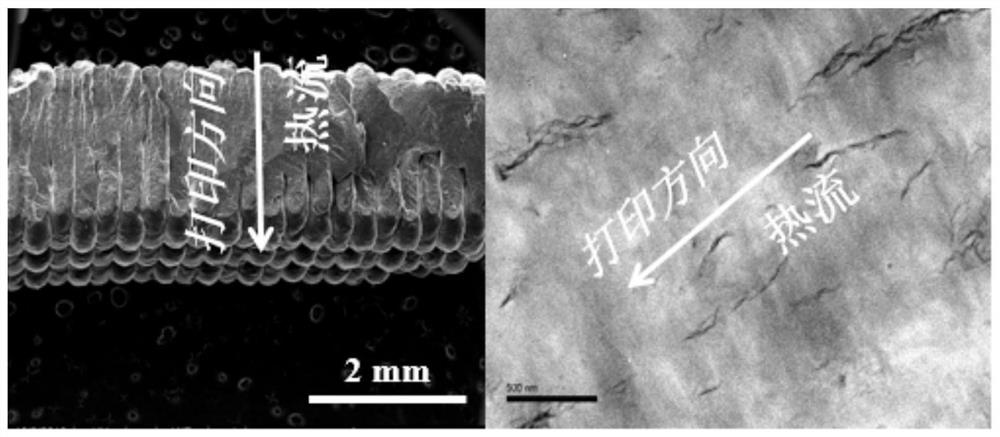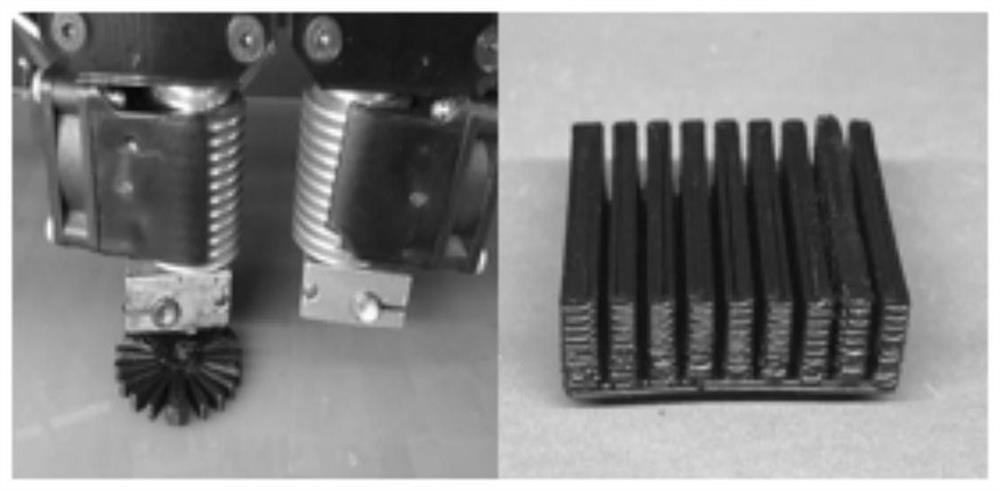Manufacturing method for 3D printing workpiece with high interfacial heat conductivity
A technology of thermal conductivity and 3D printing, applied in 3D object support structures, additive manufacturing, manufacturing tools, etc., can solve problems such as non-continuous production, prone to defects in plate products, and inability to obtain parts with high thermal conductivity between surfaces
- Summary
- Abstract
- Description
- Claims
- Application Information
AI Technical Summary
Problems solved by technology
Method used
Image
Examples
Embodiment 1
[0052] This embodiment adopts a method for preparing a 3D printed part with high thermal conductivity between surfaces, which includes the following steps in parts by weight:
[0053] (1) After mixing 100 parts of low-density polyethylene and 20 parts of graphene nanosheets, add them to a disc-shaped mechanochemical reactor for grinding and pulverization. After the grinding is completed, collect carbon-based fillers and evenly disperse them in the polymer matrix. Composite material powder; among them, the process parameters of the disc-shaped mechanochemical reactor are: the grinding pressure is 30MPa, the temperature of the disc surface is controlled by feeding a constant temperature circulating liquid medium with a temperature of 35°C, cyclic grinding 6 times, and the disc rotation speed 30r / min;
[0054] (2) Extrude the composite material powder obtained in step (1) to obtain a filament for 3D printing. The extrusion processing parameters are: extrusion temperature 170°C, ...
Embodiment 2
[0064] This embodiment adopts a method for preparing a 3D printed part with high thermal conductivity between surfaces, which includes the following steps in parts by weight:
[0065] (1) After mixing 100 parts of low-density polyethylene and 20 parts of carbon nanotubes, they are added to a disc-shaped mechanochemical reactor for grinding and pulverization. After the grinding is completed, carbon-based fillers are collected and evenly dispersed in the polymer matrix. Material powder; among them, the process parameters of the disc-shaped mechanochemical reactor are as follows: the grinding pressure is 25MPa, the temperature of the disc surface is controlled by feeding a constant temperature circulating liquid medium with a temperature of 35°C, and the grinding cycle is 6 times, and the rotational speed of the disc is 30r / min;
[0066] (2) Extrude the composite material powder obtained in step (1) to obtain a filament for 3D printing. The extrusion processing parameters are: e...
Embodiment 3
[0076] This embodiment adopts a method for preparing a 3D printed part with high thermal conductivity between surfaces, which includes the following steps in parts by weight:
[0077] (1) After mixing 100 parts of low-density polyethylene and 40 parts of graphene nanosheets, add them to a disc-shaped mechanochemical reactor for grinding and pulverization. After the grinding is completed, collect carbon-based fillers and evenly disperse them in the polymer matrix. Composite material powder; Among them, the process parameters of the disc-shaped mechanochemical reactor are: the grinding pressure is 30MPa, the temperature of the disc surface is controlled by feeding a constant temperature circulating liquid medium at a temperature of 40°C, and the grinding cycle is 6 times, and the disc rotation speed is 30r / min;
[0078] (2) Extrude the composite material powder obtained in step (1) to obtain a filament for 3D printing. The extrusion processing parameters are: extrusion temperat...
PUM
| Property | Measurement | Unit |
|---|---|---|
| tensile strength | aaaaa | aaaaa |
| tensile strength | aaaaa | aaaaa |
| tensile strength | aaaaa | aaaaa |
Abstract
Description
Claims
Application Information
 Login to View More
Login to View More - R&D
- Intellectual Property
- Life Sciences
- Materials
- Tech Scout
- Unparalleled Data Quality
- Higher Quality Content
- 60% Fewer Hallucinations
Browse by: Latest US Patents, China's latest patents, Technical Efficacy Thesaurus, Application Domain, Technology Topic, Popular Technical Reports.
© 2025 PatSnap. All rights reserved.Legal|Privacy policy|Modern Slavery Act Transparency Statement|Sitemap|About US| Contact US: help@patsnap.com



